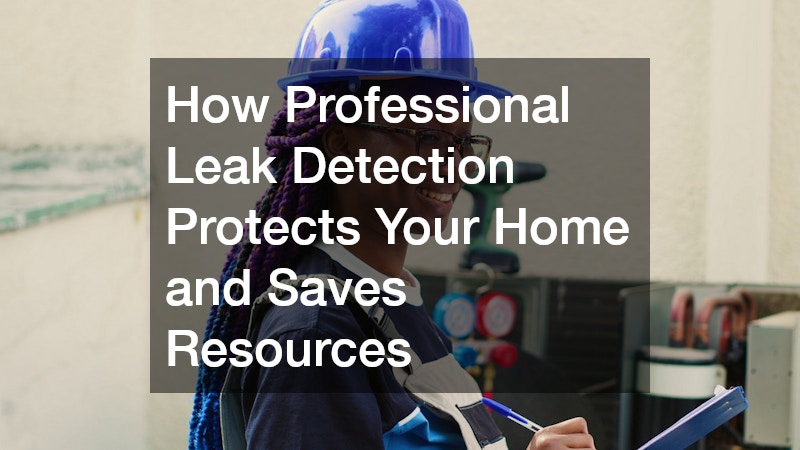Water leaks are among the most common and potentially damaging issues that homeowners and property managers face. Whether it’s a hidden pipe leak, a dripping faucet, or a slab leak beneath your home, even small amounts of undetected water can cause major structural damage, mold growth, and wasted resources over time. That’s why professional leak detection plays a vital role in maintaining your property’s safety, longevity, and efficiency.
The Importance of Early Leak Detection
Leaks can occur in places that aren’t always obvious, like behind walls, under flooring, or in the foundation. These hidden leaks often go unnoticed until they’ve caused significant damage.
Professional leak detection services are designed to identify even the smallest leaks early, often before visible signs appear.
Catching a leak in its earliest stages helps prevent water damage to drywall, flooring, and insulation. It also reduces the risk of mold growth, which can be harmful to both the building’s structure and its occupants’ health. Early detection also helps prevent excessive water usage, preserving natural resources and reducing the environmental impact of wasted water.
Signs That You May Have a Leak
Homeowners don’t always realize there’s a problem until it’s too late. Knowing the common warning signs of a leak can help you take action before extensive damage occurs. Common indicators include:
-
Sudden drops in water pressure
-
Unexplained wet spots on walls, ceilings, or floors
-
A musty or moldy smell in parts of the house
-
Sounds of running water when no taps are in use
-
Higher than normal water bills without an increase in usage
If any of these signs appear, it’s important to contact a professional leak detection service to investigate further.
How Leak Detection Works
Modern leak detection involves a variety of advanced, non-invasive technologies that allow professionals to pinpoint the source of a leak without tearing through walls or floors. These tools include:
-
Acoustic sensors that detect the sound of water escaping from pipes
-
Infrared thermography that spots temperature changes behind walls due to moisture
-
Moisture meters to measure the dampness in building materials
-
Video pipe inspection using small cameras threaded through plumbing systems
These methods allow technicians to locate leaks quickly and accurately, often without needing to damage any part of your home in the process.
Common Areas Where Leaks Occur
Leaks can happen anywhere water is present, but some areas are more prone to issues than others. Common problem areas include:
-
Bathrooms: Leaky toilets, showers, and under-sink plumbing are frequent culprits.
-
Kitchens: Dishwasher lines, faucets, and garbage disposals can all develop leaks.
-
Laundry rooms: Washing machine hoses and drainage lines are common sources of water leaks.
-
Basements: These areas are often subject to water seepage, especially in older homes with aging foundations or poor drainage.
-
Exterior plumbing: Irrigation systems, outdoor spigots, and buried water lines are also vulnerable and can leak without any visible signs.
A full inspection by a leak detection professional ensures that all potential problem areas are checked and verified.
The Role of Leak Detection in Preventive Maintenance
Leak detection isn’t just for when something goes wrong — it’s also a key part of any preventive maintenance plan. Routine inspections of plumbing systems, especially in older homes or buildings with a history of issues, can help prevent future leaks.
Many property owners schedule annual or semi-annual leak inspections to stay ahead of any potential plumbing failures. This proactive approach can extend the lifespan of pipes and plumbing fixtures and helps ensure that small issues don’t turn into large, costly repairs.
Health and Safety Considerations
Beyond property damage, water leaks can also impact your health. When moisture accumulates in hidden areas, mold and mildew can grow rapidly. Certain types of mold, such as black mold, are known to cause respiratory issues, especially in individuals with allergies, asthma, or weakened immune systems.
Standing water from leaks also increases the risk of slip and fall injuries, especially in commercial buildings or homes with children or elderly residents. Effective leak detection mitigates these risks by addressing the root cause of water accumulation quickly and efficiently.
Why Professional Help Matters
While it might be tempting to handle leak detection on your own, many leaks are not easy to find without specialized equipment and training. DIY solutions often only treat the symptom and not the source, leaving room for recurring problems.
Certified professionals bring experience, diagnostic tools, and technical knowledge that allows them to provide thorough, reliable results. A proper inspection and detection job saves time and protects your home from future problems.
Water damage can be silent, slow, and destructive—but it’s also preventable. Whether you’re noticing signs of moisture or simply want to ensure the integrity of your plumbing system, professional leak detection offers a powerful solution. By addressing hidden leaks early, you can protect your home, conserve resources, and enjoy peace of mind knowing your property is secure.

